| |
|
|
36.
| The Theorist |
| |

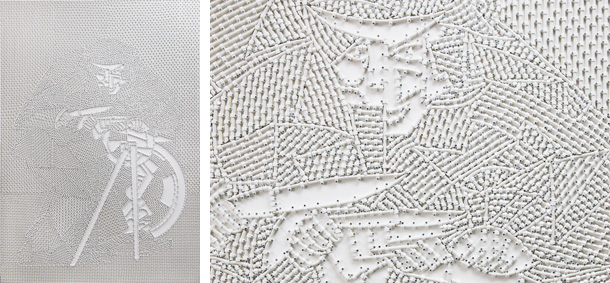
2013, 200 x 140 cm, coaxial antenna cable, staples, plexicase.
Exhibition view from They were blind, they only saw images, Galerie Yvon Lambert, 2014, Paris.
Courtesy of the artist and Ceysson & Bénétière, Paris.
'' mounir fatmi proposes a remake of the Theorist, one of Malevich’s last figurative paintings
before he switched to Suprematism and before
the Bolshevik power condemned his art and locked him up, judging abstract art as useless. ''
François Salmeron, Paris-Art, 2014
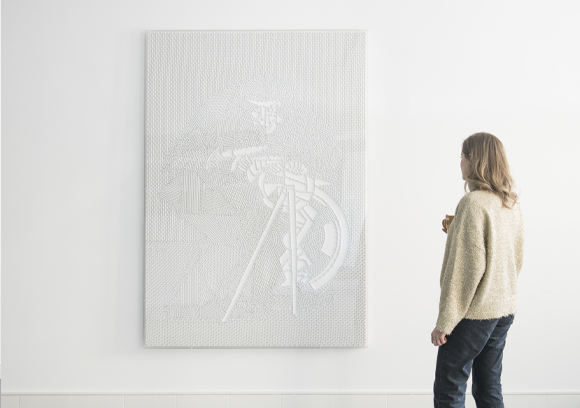
The Theorist
Exhibition view from The Process, Wilde Gallery, 2019, Geneva.
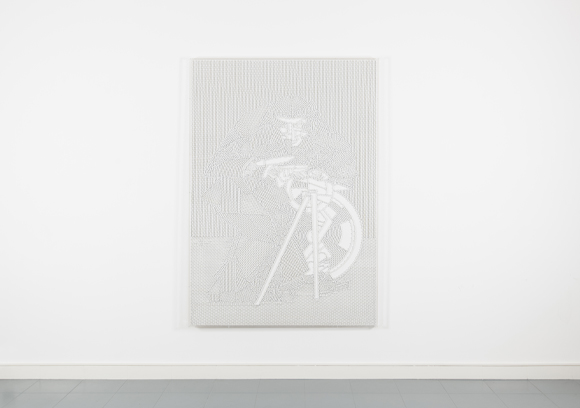
The Theorist
Exhibition view from The Process, Wilde Gallery, 2019, Geneva.
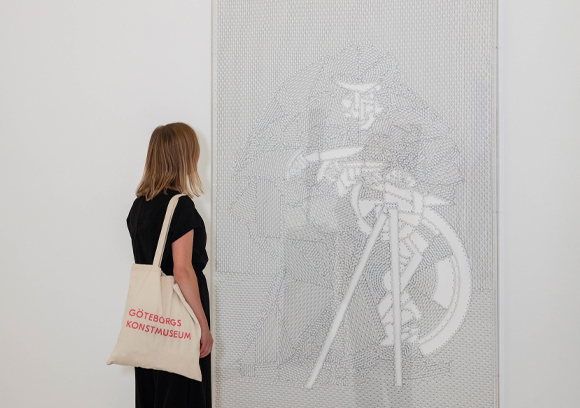
The Theorist
Exhibition view from 180° Behind Me, Göteborgs Konsthall, 2018, Göteborg.
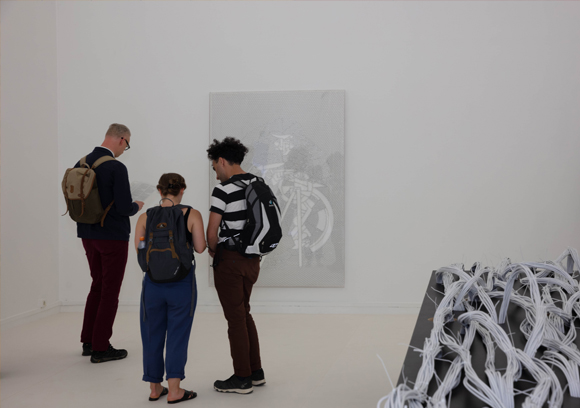
The Theorist
Exhibition view from 180° Behind Me, Göteborgs Konsthall, 2018, Göteborg.
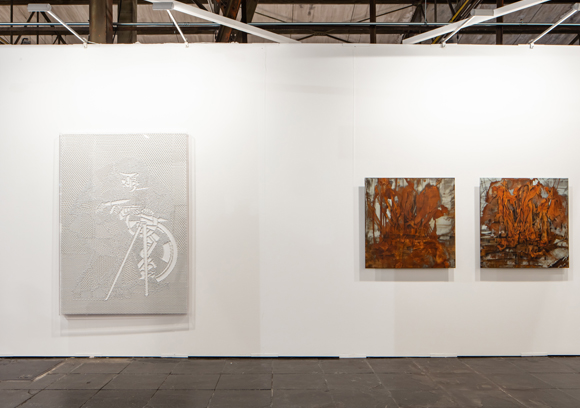
The Theorist
Exhibition view from Art Dusseldorf, 2018, Dusseldorf.
|
|
|
|
|
|
Apparaissant au milieu d'une multitude de formes géométriques blanches sur fond blanc, Le Théoricien ne se laisse pas reconnaître au premier coup d'œil et exige un effort de distinction de la part du spectateur. L'œuvre est un bas-relief réalisé au moyen de câbles coaxiaux blancs - matériau de transmission des images utilisé par Mounir Fatmi depuis ses débuts - assemblés en formes géométriques diverses et accrochés à un panneau blanc à l'aide des attaches blanc à tête rondes.
Le Théoricien pose la question de la formation artistique à travers les formes du modèle, de la copie et de l'original. L'œuvre s'intéresse en particulier à une étape charnière dans l'histoire de l'art et dans l'itinéraire d'un artiste et explore le moment qui précède un basculement esthétique menant à la disparition du sujet en peinture. Le Théoricien fait ainsi référence à "L'Aiguiseur de Couteaux" de Malévitch, toile peinte en 1912, qui mêle des influences futuristes et cubistes - où le sujet se discerne encore, mais tend à disparaître sous l'effet de l'accumulation des motifs géométriques. "L'Aiguiseur de Couteau" se tient à mi-chemin entre la figuration et l'abstraction totale, et annonce la période suprématiste de Malévitch qui rompt définitivement avec la représentation figurative. Le titre choisi par Mounir Fatmi pour son œuvre, en opérant une substitution des termes, suggère un rapport d'équivalences, et incite à appréhender rémouleur et théoricien comme les métaphores d'un même processus artistique.
Le Théoricien qui fait honneur à l'abstraction géométrique et à la couleur blanche n'est donc pas un simple hommage ou une copie de l'œuvre de Malévitch. Le Théoricien revit et fait revivre un moment décisif d'un itinéraire intellectuel et une étape importante vers la maturation artistique. Le spectateur est invité à revivre un moment de l'histoire de l'art en tant que processus psychologique : il expérimente la tentation de s'accrocher à la reconnaissance des formes et à la représentation figurative, et se met éventuellement à réfléchir sur les processus de perception qui lui permettent d'"évaluer" une œuvre ou d'identifier un sujet. En produisant sa propre interprétation d'un moment dans la carrière de Malévitch, Mounir Fatmi réalise une opération qui consiste à insuffler de l'autonomie dans son œuvre, afin d'affirmer les moyens de son art et son style et de formuler son manifeste poétique : un post-minimalisme qui fusionne la vie, l'artiste et son œuvre, qui maintient les frontières poreuses et se tient à la lisière entre l'abstraction et le motif signifiant et polysémique. Doué d'une grande plasticité, son langage autorise dans le même temps les projections fantasmatiques et leurs critiques, la mise en action des sens et la réflexion sur les processus de perception.
Studio Fatmi, Février 2017. |
|
Appearing in the midst of a multitude of geometric shapes against a white background, the Theorist doesn’t let itself be recognized at first glance and requires an effort on the part of the viewer to discriminate the subject. The work is a bas-relief created with white coaxial cables – a material used for the transmission of images that has been employed by Mounir Fatmi since his beginnings – assembled into various geometric shapes and pinned to a white panel with rounded tacks.
The Theorist poses the question of artistic training through the figures of the model, the copy and the original. The work particularly focuses on a pivotal stage in art history and in the itinerary of an artist and explores the moment preceding an esthetic shift leading to the disappearance of the subject in painting. The Theorist thus references Malevitch’s “Knife Sharpener”, painted in 1912, which combines futuristic and cubist influences, and where the subject can still be distinguished but tends to disappear behind an accumulation of geometric motifs. “The Knife Sharpener” stands halfway between figuration and complete abstraction and heralds Malevitch’s supremacist period where he definitively abandoned figurative representation. The title chosen by Mounir Fatmi for his work, operating a substitution of terms, suggests an equivalency of propositions and the idea of viewing the knife sharpener and the theorist as two metaphors of the same artistic process.
Consequently, the Theorist, which puts forward geometrical abstraction and the color white, isn’t a simple homage or a copy of Malevitch’s painting. It revives a decisive moment in an intellectual journey and an important step towards artistic maturity. The viewer is invited to relive a moment in art history as a psychological process: he experiences the temptation of holding on to the recognition of shapes and figurative representation and might start reflecting about the processes of perception that enable him to “evaluate” a work of art or identify a subject. By offering his own interpretation of a moment in Malevitch’s career, Mounir Fatmi carries out an operation that consists in injecting autonomy into his work in order to affirm the means of his art and style, and to formulate a poetic manifesto: a post-minimalism that fuses life, the artist and his work, that keeps boundaries porous and stands on the border between abstraction and the signifying and polysemous motif. His language, with its strong plasticity, simultaneously allows phantasmal projections and their critique, the engagement of the senses and a reflection on the processes of perception.
Studio Fatmi, February 2017. |
|
|
|